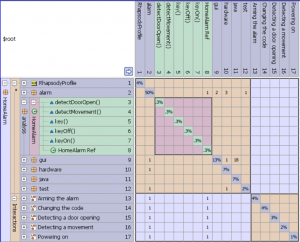With Lattix Architecture Analysis for UML/SysML it is now possible to easily construct a Design Structure Matrix that unites the various perspectives of UML and SysML systems modeling approaches into a scalable big-picture view. The Design Structure Matrix techniques support the management of complexity by focusing attention on the elements of a complex system and how they relate to each other. These techniques have proven to be very valuable in understanding, design and optimizing complex systems, including system architectures, organizations, and process.During the earliest stages of design, it is possible to identify undesirable interdependencies and expose key design decisions for the entire team. Rules can be established in the Design Structure Matrix model for compliance to guide the system developers during development and testing for validation. Over time, the Design Structure Matrix will provide a blueprint of the system architecture and how it evolves to meet changing needs.

This is the DSM of the Home Alarm UML model from IBM Rational
In this DSM, the static view of the system (such as package and class diagrams) and the behavioral views (such as state and interaction diagrams) have been combined together in order to understand the overall picture. Because these diagrams contain requirements, use case scenarios and design information, the DSM can now be used to unite these different perspectives into a single view so that the impact of change to a requirement can be more readily understood.
Lattix Acan import data from Excel, Sparx Enterprise Architect, MagicDraw, XML (XMI) or IBM Rhapsody.
Lattix Architecture Analysis for UML/SysML has these unique features:
- Explore dependencies between various model elements including requirements, use case scenarios, and design information
- Identify problematic dependencies such coupling and violations of the architectural intent
- Rules can be established in the DSM model for compliance to guide the system developers during model development and testing for validation.
(video) How to create a Design Structure Matrix from Excel in Lattix
A Multi-Domain Matrix (MDM) can include business processes, the IT requirements derived from them, and the systems which deliver them. Underlying it all can be the people from various disciplines who develop the system throughout its lifecycle. Each cell of the Design Structure Matrix represents the mapping of dependencies from one domain to another. Using this information, it is also possible to automatically infer additional dependencies within the domains.


